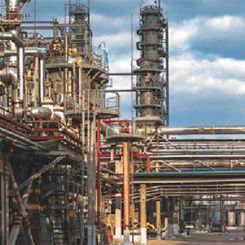Centrifugal pumps are one of the world’s most commonly used machines. Every day, test labs evaluate their performance. Most of these pumps have been designed to transport fluids or create pressure in an industrial process. Therefore, the most important measurements include pump pressure (head), flow and power, and maintenance and environmental factors—such as vibration, sound levels and operating temperature. What should the test engineer consider when the main purpose of a pump is not the movement of fluids—but the transport of rocks, sand, gravel and mud? A centrifugal pump is usually not considered for such purposes, but that is exactly what slurry pumps do in the mining and dredging industries. Although water (or some other fluid) is always present with the solids in slurry pump operations, it is usually only a carrier. While it may be recycled, the power expended to move and pressurize it is lost energy. In some cases, the presence of water adds disadvantages to the process—such as in dredging operations focused on land building for ports and harbors, or in mining operations in which large amounts of rock remaining after the ore has been removed must be returned to the landscape in an environmentally responsible and geologically stable manner. Reducing water use to the bare minimum can be important in these cases to ensure stability and to conserve scarce water resources. A large portion of the water that transports these solids remains in the ground and must be replaced—even a bucket of wet dirt is 35 percent water.
 Image 1. Extreme impeller inlet edge wear due to large solids impact
Image 1. Extreme impeller inlet edge wear due to large solids impact Image 2. Mounting of impact wear samples in pipeline
Image 2. Mounting of impact wear samples in pipelinePumping Boulders
In some applications, such as dredging a new channel or in the “hydrotransport” of phosphate matrix and oil sands, the largest solids can exceed 100 millimeters (mm), or 4 inches, in diameter. At this size, impact wear at the impeller inlet and casing cutwater will often limit service life. While several tests exist for quantifying slurry wear resistance, they invariably use sand-sized particles, so little is known about the impact resistance of typical slurry pump materials under more extreme loads. Because many such materials are relatively hard and brittle, this issue cannot be overlooked. Key questions include:- Do the relative rankings of materials change as the impact becomes more severe?
- Is there a limit of strength or toughness that must be maintained?
- Does the third power relationship between impact velocity and wear still hold true?
 Image 3. Slurry pump and solids for impact wear testing
Image 3. Slurry pump and solids for impact wear testingPumping Pastes
In many mining applications, the ore contains small amounts of metal. For example, many copper mines contain less than 1 percent copper. The process of extracting the valuable metals requires extensive grinding and processing of the ore at the rate of thousands of tons per day. Once the concentrated metal bearing minerals are removed for smelting, 97 percent of the solids may remain for reclamation into the environment. As mentioned above, these solids should be placed at the highest concentration possible to ensure a geologically stable landscape and conserve water resources. These are often finely ground, sized to 100 microns or less, and form a thick paste with non-Newtonian fluid properties. Often, transportation must extend several kilometers and friction losses in the pipeline can be high. Image 4. Comparison of various impact wear samples
Image 4. Comparison of various impact wear samplesSlurry Testing
Hopefully, these examples help explain the challenges and rewards of slurry testing. Although often less than exact, usually somewhat messy and frequently without established guidelines, slurry testing places the engineer in direct contact with complex fluid dynamics problems of practical economic interest and offers the opportunity to take a hands-on area of scientific study from the empirical to the theoretical.-paste-type-slurry.jpg) Image 5. Typical high yield stress (but still pumpable) paste-type slurry
Image 5. Typical high yield stress (but still pumpable) paste-type slurry
